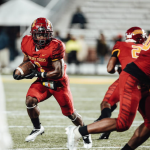A brief history of public education in Alabama: Part II
By Guest columnist Kyle Whitmire

The United States military understood something a century ago that many folks still don’t get today — there are some people who aren’t smart enough to trust with a gun.
In 1917, the United States Department of War experimented with a novel idea. While sifting and sorting conscripts for World War I, it put to use intelligence tests to see which draftees were suitable for combat and in which roles.
Alabama flunked the test.
Alabamians, white and Black, scored so badly that many had to be sent home rather than to the front lines for fear they might shoot the wrong people.
And these tests also showed something else — white people in Alabama scored worse than Black people outside the South. Standardized testing and intelligence tests have a nasty history of abetting racism, but this one showed white superiority to be a lie.
And what Alabama had done to perpetuate that lie was hurting everybody.
This shouldn’t have been a surprise. Alabama’s new constitution promised a right to an education, but it didn’t do much to fund it. The state’s anemic education system kept poor people where the south Alabama planters and north Alabama industrialists wanted them — in the fields, factories and mines.
White schools got little. Black schools got much less.
In 1930, Lowndes County spent $96 per pupil for white schools, according to Alabama historian Wayne Flynt. For Black children, it spent $5.
The WWI intelligence tests embarrassed the state, and several elected leaders from that period sometimes get credit for being “progressives” who championed reforms. But for most of the 20th century, education reform in Alabama meant meeting the minimum expectations of white people while ignoring the needs of Black people.
Until 1954, when things got even worse.
Brown vs. Board of Education of Topeka set in motion the desegregation of public schools, and in 1956, Alabama resisted with suicidal defiance.
Amendment 111 to the Alabama Constitution of 1901 rescinded the state’s right to an education.
Later, the state enacted even more restrictions on property tax, and whites in majority-Black areas either moved en masse or enrolled their children in hacked-together seg academies. The post-Reconstruction fear of “negro rule” was very much alive in white Alabama and resulted in the widespread abandonment of public schools.
By 1990, a coalition of rural schools sued Alabama for its pathetic support of public education. At trial, witnesses described schools without libraries, schools where textbooks were older than the students, schools that were structurally unsound, unsanitary and infested with vermin.
The Alabama Supreme Court ruled that, despite the obvious inequity and inadequacy, only the Legislature had the authority to do something about it.
The Legislature responded as it often does — by doing nothing.
It’s not sufficient to say Alabama has failed its students. “Failure” implies some kind of accident.
What Alabama did to its school children, it did on purpose.

When we talk about white supremacy
I’ve been throwing around the word “poor” a lot, despite it being out of fashion. Recently, listening to public radio, I heard a host tell of a book drive for “under-resourced” kids, which sounds like a logistical problem.
There is nothing shameful about being poor in Alabama. The shame belongs to lawmakers and lobbyists in Montgomery and c-suite executives in Birmingham who’ve let this travesty go on for 120 years.
Rather than fix disparities in public education, lawmakers have shamed “failing schools” and invented new ways to raid school funds to subsidize private academies.
We do not control what we inherit, but we do control what we do with it. The poor have not inherited anything but their poverty, which they get the day they are born.
But the political and economic descendants of those 1901 conventioneers have preserved a system that should have been obliterated and replaced a long time ago.
A system designed to preserve white supremacy.
When I was growing up, I thought “white supremacy” meant the Klan or neo-Nazis — whose numbers by then had dwindled to a handful of goofy extremists. They held pathetic little marches in far-away cities or played freak-of-the-week on daytime talk shows like “Geraldo.” It was on one of these shows that I first heard the n-word. My grandmother, who had been watching with me at her house, shuddered.
“We don’t talk like that,” she told me. “We say ‘colored.’”
But what these groups had done in the past was seldom a topic of conversation. No one taught us how Klan membership had been a virtual prerequisite for public office in Alabama — for governors, senators and one eventual U.S. Supreme Court justice.
Nor did they say that, until a few years before I was born, the state’s one functional political party had proudly proclaimed “white supremacy, for the right” at the top of its primary ballots.
No one taught us that the foundational law of our state had been written with the explicit purpose of “White Supremacy by Law.”










